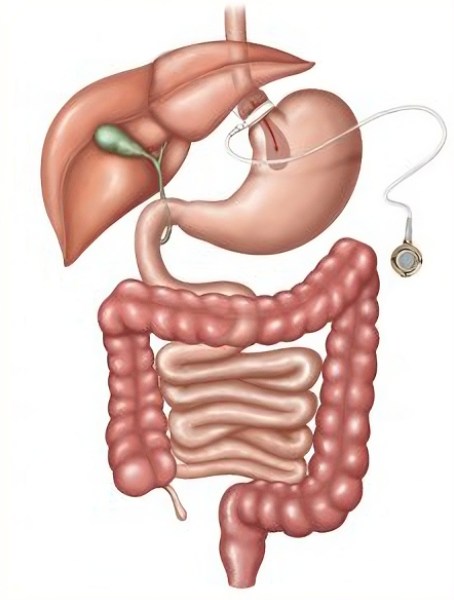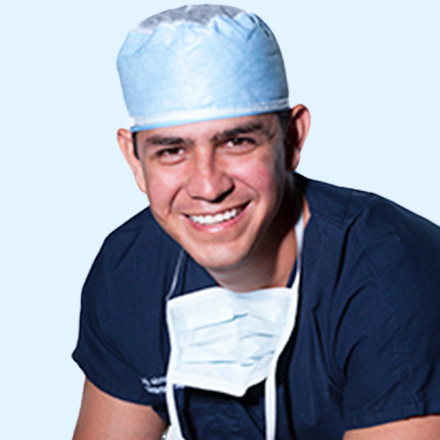Gastric Band in Mexico
The Gastric Band Mexico surgery, or laparoscopic adjustable banding is a bariatric surgery procedure that uses an adjustable belt placed around the upper portion of the stomach. This band is made out of silicone and is designed to constrict the size of the stomach and the amount of food that can be held in the stomach. At the same time, it slows down the passage of food to the intestines which helps signal to the brain that the stomach is full. The band is filled with saline which can be increased or decreased based upon your needs and your doctors recommendations. A small port is accessed near the surface of the skin that your doctor can then add or remove saline through. Adding saline tightens the band and shrinks the size of the stomach pouch that can accept food. This should make you feel fuller, quicker and decrease the appetite and as a result help you lose weight.
What Is Gastric Band Surgery?
The Gastric Band Mexico surgery, or laparoscopic adjustable banding is a bariatric surgery procedure that uses an adjustable belt placed around the upper portion of the stomach. This band is made out of silicone and is designed to constrict the size of the stomach and the amount of food that can be held in the stomach. At the same time, it slows down the passage of food to the intestines which helps signal to the brain that the stomach is full. The band is filled with saline which can be increased or decreased based upon your needs and your doctors recommendations. A small port is accessed near the surface of the skin that your doctor can then add or remove saline through. Adding saline tightens the band and shrinks the size of the stomach pouch that can accept food. This should make you feel fuller, quicker and decrease the appetite and as a result help you lose weight.
While gastric banding is meant to be a long term weight loss remedy, some people will require a follow up procedure to repostion, replace or remove the gastric band. This could be due to complications or ineffectiveness of the band.
There are two primary options you can choose from when deciding if a gastric band is the right option for you. The LAP-Band and REALIZE Band are very similar in many ways but there are slight differences between the two.
Learn more about the Gastric Sleeve surgery by clicking the FAQ tab on the left or view our pricing options in our surgeon network bellow.
If you ready to change and improve your life and be one more of our thousands of patient weight loss success stories, complete our eligibility questionnaire on the right.

What is included in your surgery?
Surgery Duration
30 minutes
Nights in Hospital
2 Nights
Nights in Hotel
1 Pre Operative
Back to Work
1 to 3 weeks

$4,499
USD
- Gastric Sleeve in Tijuana
-
Obesity Goodbye Hospital
(2 Nights Recovery) -
Top-Tier Collaboration
(TWO Certified Bariatric Surgeons 50+ Years combined experience) - Surgery Duration ½ Hour
- Grand Hotel Pre-op Night
- Anesthesiologist
- Medication
- FDA Products Used
- Nutritionist
- Transportation
- Coordinator
- Counts w/ International Airport (San Diego, CA. USA)
- Explore About Tijuana
$5,499
USD
- Single Incision Sleeve in Tijuana
-
Obesity Goodbye Hospital
(2 Nights Recovery) -
Top-Tier Collaboration
(TWO Certified Bariatric Surgeons 50+ Years combined experience) - Surgery Duration ½ Hour
- Grand Hotel Pre-op Night
- Anesthesiologist
- Medication
- FDA Products Used
- Nutritionist
- Transportation
- Coordinator
- Counts w/ International Airport (San Diego, CA. USA)
- Explore About Tijuana
$6,499
USD
- Mini Gastric Bypass in Tijuana
-
Obesity Goodbye Hospital
(2 Nights Recovery) -
Top-Tier Collaboration
(TWO Certified Bariatric Surgeons 50+ Years combined experience) - Surgery Duration ½ Hour
- Grand Hotel Pre-op Night
- Anesthesiologist
- Medication
- FDA Products Used
- Nutritionist
- Transportation
- Coordinator
- Counts w/ International Airport (San Diego, CA. USA)
- Explore About Tijuana
$7,299*
USD
- Revision Surgery in Tijuana
-
Obesity Goodbye Hospital
(2 Nights Recovery) -
Top-Tier Collaboration
(TWO Certified Bariatric Surgeons 50+ Years combined experience) - Surgery Duration 1 Hour
- Grand Hotel Pre-op Night
- Anesthesiologist
- Medication
- FDA Products Used
- Nutritionist
- Transportation
- Coordinator
- Counts w/ International Airport (San Diego, CA. USA)
- Explore About Tijuana

$5,699
USD
- Gastric Sleeve in Cancun
-
Presbiteriano Hospital
(2 Nights Recovery) - (2) 25+ year experienced Certified Bariatric Surgeons
- Surgery Duration ½ Hour
- La Quinta Hotel
- Anesthesiologist
- Medication
- FDA Products Used
- Nutritionist
- Transportation
- Coordinator
- Counts w/ International Airport
- Explore About Cancun
$6,699
USD
- Single Incision Sleeve in Cancun
-
Presbiteriano Hospital
(2 Nights Recovery) - (2) 25+ year experienced Certified Bariatric Surgeons
- Surgery Duration ½ Hour
- La Quinta Hotel
- Anesthesiologist
- Medication
- FDA Products Used
- Nutritionist
- Transportation
- Coordinator
- Counts w/ International Airport
- Explore About Cancun
$7,699
USD
- Mini Gastric Bypass in Cancun
-
Presbiteriano Hospital
(2 Nights Recovery) - (2) 25+ year experienced Certified Bariatric Surgeons
- Surgery Duration ½ Hour
- La Quinta Hotel
- Anesthesiologist
- Medication
- FDA Products Used
- Nutritionist
- Transportation
- Coordinator
- Counts w/ International Airport
- Explore About Cancun
$8,499*
USD
- Revision Surgery in Cancun
-
Presbiteriano Hospital
(2 Nights Recovery) - (2) 25+ year experienced Certified Bariatric Surgeons
- Surgery Duration ½ Hour
- La Quinta Hotel
- Anesthesiologist
- Medication
- FDA Products Used
- Nutritionist
- Transportation
- Coordinator
- Counts w/ International Airport
- Explore About Cancun

$4,999
USD
- Gastric Sleeve in Cabo San Lucas
-
Clinick Hospital Cabo
(2 Nights Recovery) - 15+ year experienced Certified Bariatric Surgeon
- Surgery Duration ½ Hour
- Anesthesiologist
- Medication
- FDA Products Used
- Fairfield Marriott Hotel 2 Nights
- Nutritionist
- Transportation
- Coordinator
- Counts w/ International Airport
- Explore About Cabo San Lucas
$5,999
USD
- Single Incision Sleeve in Cabo
-
Clinick Hospital Cabo
(2 Nights Recovery) - 15+ year experienced Certified Bariatric Surgeon
- Surgery Duration ½ Hour
- Anesthesiologist
- Medication
- FDA Products Used
- Fairfield Marriott Hotel 2 Nights
- Nutritionist
- Transportation
- Coordinator
- Counts w/ International Airport
- Explore About Cabo San Lucas
$6,999
USD
- Mini Gastric Bypass in Cabo
-
Clinick Hospital Cabo
(2 Nights Recovery) - 15+ year experienced Certified Bariatric Surgeon
- Surgery Duration ½ Hour
- Anesthesiologist
- Medication
- FDA Products Used
- Fairfield Marriott Hotel 2 Nights
- Nutritionist
- Transportation
- Coordinator
- Counts w/ International Airport
- Explore Cabo San Lucas
$7,799*
USD
- Gastric Revision surgery in Cabo
-
Clinick Hospital Cabo
(2 Nights Recovery) - 15+ year experienced Certified Bariatric Surgeon
- Surgery Duration 1 Hour
- Anesthesiologist
- Medication
- FDA Products Used
- Fairfield Marriott Hotel 2 Nights
- Nutritionist
- Transportation
- Coordinator
- Counts w/ International Airport
- Explore Cabo San Lucas

$4,999
USD
- Gastric Sleeve in Puerto Vallarta
- San Javier Medical Center 2 Nights
- 20+ year experienced Certified Bariatric Surgeon
- Surgery Duration ½ Hour
- Anesthesiologist
- Medication
- FDA Products Used
- Holiday Inn Express Hotel 2 Nights
- Nutritionist
- Transportation
- Coordinator
- Counts w/ International Airport
- Explore About Puerto Vallarta
$5,999
USD
- SIS in Puerto Vallarta
- San Javier Medical Center 1 Nights
- 20+ year experienced Certified Bariatric Surgeon
- Surgery Duration ½ Hour
- Anesthesiologist
- Medication
- FDA Products Used
- Holiday Inn Express Hotel 2 Nights
- Nutritionist
- Transportation
- Coordinator
- Counts w/ International Airport
- Explore About Puerto Vallarta
$6,999
USD
- Mini Gastric Bypass in Puerto
- San Javier Medical Center 2 Nights
- 20+ year experienced Certified Bariatric Surgeon
- Surgery Duration ½ Hour
- Anesthesiologist
- Medication
- FDA Products Used
- Holiday Inn Express Hotel 2 Nights
- Nutritionist
- Transportation
- Coordinator
- Counts w/ International Airport
- Explore About Puerto Vallarta
$7,799*
USD
- Gastric Revision Surgery in Puerto
- San Javier Medical Center 2 Nights
- 20+ year experienced Certified Bariatric Surgeon
- Surgery Duration ½ Hour
- Anesthesiologist
- Medication
- FDA Products Used
- Holiday Inn Express Hotel 2 Nights
- Nutritionist
- Transportation
- Coordinator
- Counts w/ International Airport
- Explore About Puerto Vallarta

$7,999
USD
- Gastric Sleeve in Monterrey
-
Swiss Hospital
(2 Nights Recovery) - 20+ year experienced Certified Bariatric Surgeon
- Surgery Duration ½ Hour
- Anesthesiologist
- Medication
- FDA Products Used
-
Hotel Not needed
(Add 2 Night Hospital Stay) - Nutritionist
- Transportation
- Coordinator
- Counts w/ International Airport
- Explore About Monterrey
$8,999
USD
- SIS in Monterrey
-
Swiss Hospital
(2 Nights Recovery) - 20+ year experienced Certified Bariatric Surgeon
- Surgery Duration ½ Hour
- Anesthesiologist
- Medication
- FDA Products Used
-
Hotel Not needed
(Add 2 Night Hospital Stay) - Nutritionist
- Transportation
- Coordinator
- Counts w/ International Airport
- Explore About Monterrey
$9,699
USD
- Mini Gastric Bypass in Monterrey
-
Swiss Hospital
(2 Nights Recovery) - 20+ year experienced Certified Bariatric Surgeon
- Surgery Duration ½ Hour
- Anesthesiologist
- Medication
- FDA Products Used
-
Hotel Not needed
(Add 2 Night Hospital Stay) - Nutritionist
- Transportation
- Coordinator
- Counts w/ International Airport
- Explore About Monterrey
$10,299*
USD
- Gastric Revision Surgery Monterrey
-
Swiss Hospital
(2 Nights Recovery) - 20+ year experienced Certified Bariatric Surgeon
- Surgery Duration 1 Hour
- Anesthesiologist
- Medication
- FDA Products Used
-
Hotel Not needed
(Add 2 Night Hospital Stay) - Nutritionist
- Transportation
- Coordinator
- Counts w/ International Airport
- Explore About Monterrey

$5,650
USD
- Gastric Sleeve in Merida
-
Eme Hospital
(2 Nights Recovery) - 20+ year experienced Certified Bariatric Surgeon
- Surgery Duration ½ Hour
- Anesthesiologist
- Medication
- FDA Products Used
- Hotel
- Nutritionist
- Transportation
- Coordinator
- Counts w/ International Airport
- Explore About Merida
$6,650
USD
- SIS in Merida
-
Eme Hospital
(2 Nights Recovery) - 20+ year experienced Certified Bariatric Surgeon
- Surgery Duration ½ Hour
- Anesthesiologist
- Medication
- FDA Products Used
- Hotel
- Nutritionist
- Transportation
- Coordinator
- Counts w/ International Airport
- Explore About Merida
$7,650
USD
- Mini Gastric Bypass in Merida
-
Eme Hospital
(2 Nights Recovery) - 20+ year experienced Certified Bariatric Surgeon
- Surgery Duration ½ Hour
- Anesthesiologist
- Medication
- FDA Products Used
- Hotel
- Nutritionist
- Transportation
- Coordinator
- Counts w/ International Airport
- Explore About Merida
$8,650*
USD
- Gastric Revision Surgery in Merida
-
Eme Hospital
(2 Nights Recovery) - 20+ year experienced Certified Bariatric Surgeon
- Surgery Duration 1 Hour
- Anesthesiologist
- Medication
- FDA Products Used
- Hotel
- Nutritionist
- Transportation
- Coordinator
- Counts w/ International Airport
- Explore About Merida
FAQs of The Gastric Band in Mexico surgery
Advantages of the Gastric Band:
- Reversible.
- Adjustable: band can be adjusted to increase or decrease weight loss.
- Weight loss averages 40 to 60 percent of excess body weight.
- Malnutrition complications rare.
- Short hospital stay usually less than 24 hours.
- Substantial improvement in many health problems related to morbid obesity.
Disadvantages of the Gastric Band:
- Weight loss is very dependent on frequent follow-up visits.
- 1 to 2 percent long-term risk of erosion of the band into the stomach requiring revisional surgery.
- 5 to 10 percent long-term risk of stomach slippage requiring revisional surgery.
- Device may require repair with time requiring additional minor operations.
- Weight loss is VERY dependent on long-term follow-up with monthly follow-up visits for the first year.
PRE-OPERATIEF DIET
Before having weight loss surgery, your surgeon has recommended that you follow a low sugar, reduced calorie diet for the next 14 days, it is essential you follow a special pre-operative diet for two weeks prior to having weight loss surgery. Patients will need to have a liquid diet during this time; the diet is to help shrink the liver prior to surgery. A shrunken liver during surgery gives the surgeon greater access to the exposed stomach laparoscopically, when preforming surgery and makes the surgery go easier, allowing the doctor to have more room to work around the liver.
The diet is low in fats and in carbohydrates, therefore, reducing the glycogen stores. This in returns reduces the size of the liver causing it to shrink and soften. When performing bariatric surgery the surgeon will need to lift your liver to access your stomach. Having a liver which is immobile, fatty, and heavy, will make it difficult for the surgeon to see and have access to the stomach. Following this diet you will lose weight prior to surgery, and more importantly you will reduce the size of your liver, resulting in a safer surgery.
Special Instructions
**Special Note for Patients with Diabetes
If you have diabetes and are treated with insulin or a sulphonylurea tablet (gliclazide, glibenclamide, tolbutamide, glimepiride, glipizide), you will need to adjust your insulin or medication. They will need to understand your calories will be around 800/day from the time you start this diet and medication management goal is to have less medication and not more food. For this reason please contact your Diabetes Specialist Nurse/Practice Nurse/GP/PCP before starting the preoperative diet to discuss your medication and any possible adjustments needed. It is also recommended you monitor your blood sugar closely. This diet will likely be a reduction for normal intake of carbohydrates and calories. Consult with your medical provider as needed.
**Special Note for Lactose Intolerant Patients.
If dairy products including milk give you gas, cramping, bloating or diarrhea you may be lactose intolerant. It is recommended you choose Boost Diabetic for your meal replacement choice because it is lactose free. If you choose to use a protein shake made with milk products take a Lactaid or similar lactase enzyme pill at the start of each meal containing one of these products. As you will see in the Pre-Operative diet snack choices include cottage cheese, and yogurt many lactose intolerant individuals are able to consume yogurt without experiencing gas or bloating. If you choose to eat cottage cheese it is recommended you take the lactase enzyme with your cottage cheese.
**NO CAFFINE, PEPPER, ALCOHOL, PEPPERMINT & NO OATMEAL.
** No Chewing gum with sugar or carb sweetener, breath mints, cough syrup, hard candy or cough drops they contain high amounts of sugar.
** Stop usage of tobacco products during this pre-operative diet and during the post-operative care informational you will receive.
Bariatric Pre-Operative Diet
Food Consumption
There are no caloric limitations on the liver shrinking diet. You are able to eat as much and drink as much as you like from the list of allowable things. We do suggest reasonable limits to aid in your weight loss of a maximum of 40-50 carbohydrates daily. Typical protein intake between 70-120 grams a day, through protein shakes. It is suggested you take a multi-vitamin during your pre-op diet and during post-op. Many patients have stated that Premier Protein & Unjury as being some of the better tasting shake choices.
Here is the list of Pre-Op Diet food to follow before having your weight loss surgery. You will be following something very similar to a liquid diet.
- All the water you can drink
- All the natural fruit juice you can drink (make sure it has No Sugar Added on the label)
- Coffee or Tea (decaf only)
- Low fat creamer, Skim or 1% milk, Soy milk
- Sugar-free drinks only (Crystal Light, G-2 Gatorade, Diet PowerAde, Propel, etc.)
- All the broth you can eat chicken or vegetable is OK
- Please drink 3 Vitamin supplements per day Any Flavor is fine (with low sugar & carbs)
- Diet V-8 fusion, etc.
- Sugar-free Gelatin (no fruit added)
- Sugar free popsicles
- Sugar-free pudding
- All the plain yogurt you can eat (Greek yogurt has almost double the amount of protein per serving)
We are aware this can be a challenge for many of our patients to do for the entire period of time. If you get hungry it is okay the first week to eat 4 ounces of fish, lean turkey, chicken breast, ham, roast beef, but it must be baked, broiled, or grilled (NO FRIED FOODS). The day prior to surgery attempt to drink all clear liquids such as water, broth, clear juice, Kool-Aid (sugar free), pulp free drinks, lemonade, grape juice, apple juice, broth, etc.
The Night Before your Surgery, DO NOT EAT OR DRINK anything after Midnight 12 am and we need you on a 100% Fast that day when you arrive for surgery.
POST-OPERATIVE DIET
It is important for you to make healthy food choices after your surgery to help you with weight loss and to maintain your nutritional health. A changed eating pattern is important for weight loss, to avoid stomach pains, and to prevent nutritional deficiencies.
WHY SHOULD YOU FOLLOW THIS POST OPERATIVE DIET?
FOR A SUCCESSFUL WEIGHT LOSS
- To help you to achieve the maximal amount of weight loss.
- To help prevent nutritional deficiencies and other complications.
It is important to note that lifestyle and behavioral changes are necessary to be successful with your weight loss journey.
- Eat three meals a day and limit unnecessary snacking in-between meals. This weight loss surgery is a restrictive procedure, which means that the success of weight loss depends on what you are eating. Unhealthy snacking in-between meals (e.g. pretzels, crackers, cookies, etc.) or eating frequently may prevent successful weight loss or cause weight gain due to excess calorie intake.
- Eat slowly and chew your food until LIQUID. Failure to do so can cause pain, nausea, vomiting, and irritate your new pouch. It is very important to chew very thorough until it is liquid. Also, remember to cut your food into small pieces before eating it. Try waiting one minute in between bites. Allow at least 30 minutes for a meal
- Avoid concentrated sugar. Keep sugar out of the first 3 ingredients on the food label. The number of sugar grams on the label includes both added and natural sugars; therefore, it is important to read the ingredients to find out what type of sugar the food contains. Aim to keep the “sugars” down to 15 grams or less per serving to help limit “empty calories” in your diet. Avoid these simple sugars, especially if within the first 3 ingredients on food labels: sugar, dextrose, high fructose corn syrup, corn syrup, glucose, sucrose, molasses, and honey Note: Artificial sweeteners such as NutraSweet/Equal®, saccharine/Sweet & Low®, and sucralose/Splenda® are acceptable to use.
- Limit high fat foods. Low fat is 3 grams or less per serving on a food label. Examples of high fat foods: potato chips, fried foods, fast food, bacon, sausage, hot dogs, bologna, pepperoni, cream soups, Alfredo sauce, donuts, cakes, cookies, and pastries.
- Stop eating when you feel comfortably satisfied. Overeating can cause nausea, vomiting, and the size of your stomach to stretch. It can take 6-9 months for your new stomach size to stabilize.
- Drink adequate fluids to prevent dehydration. Aim for 48-64 fl oz (6-8 cups) of fluid per day.
- Sip on your beverages, no gulping!
- Avoid carbonated beverages, beverages containing sugar and alcoholic beverages.
- Choose sugar-free, non-carbonated drinks such as: Crystal light®, Fruit 2O®, Diet Snapple®, Propel Fitness Water, Light Minute Maid® drinks, Diet Ice Tea, etc.
- Limit fat free milk to less than 16 ounces per day, limit 100% real fruit juice to less than 8 ounces per day (try diluting with water).
TIPS
- Wean off carbonated and caffeinated beverages before surgery to help prevent withdrawals.
- Choose beverages with 10 calories or less per serving.
- If plain water sits heavy and you are having problems tolerating it add a sugar-free flavoring (e.g. True Lemon®, lemon or orange slice, etc.)
- Increase your fluid intake if any of the following signs are present: dark urine, headache, dizziness, lethargy, a white coating on the tongue.
- AVOID eating and drinking at the same time. Avoid drinking with your meal, then wait at least 30 minutes after a meal to resume drinking.
- Choose your food wisely, at each meal protein should be consumed first, then vegetables and fruits, then “whole” grains.
- Exercise!
- Aim for at least 30 minutes every day.
- Exercise helps maintain long-term weight loss.
- Even 5 minutes at a time, as tolerated, is a start, and increase the time and frequency as tolerated.
- The first four weeks, the primary exercise used should be walking. After four weeks, try introducing strength exercises.
- Always speak with your doctor if you have never exercised.
- Protein. You need to consume at least 60-80 grams of protein per day in the form of food and/or supplements.
| Meats, Poultry, and Fish | Portion Size | Grams of Protein |
|---|---|---|
| Beef/Turkey Jerky | 1 oz dried | 10-15 Grams |
| Beef, Pork, Poultry, Fish | 1 oz (2 Tbsp) | 7 Grams |
| Cheese, hard (low-fat) | 1 oz | 7 Grams |
| Kraft free/Healthy Choice | 1 oz 1 slice | 5 Grams |
| Borden fat free singles | 1 oz 1 slice | 5 Grams |
| Cottage cheese, Ricotta (part skim) | 2 Tbsp | 3.5 Grams |
| Imitation Crab Meat | 1 oz | 3 Grams |
| Crabmeat | 1 oz (2 Tbsp) | 6 Grams |
| Shrimp, Lobster | 1 oz | 6 Grams |
| Egg | 1 oz | 6 Grams |
| Baby Food Meat | 1 oz (2 Tbsp) | 4 Grams |
| Potted Meats/Spam Lite | 2 oz | 8.5 Grams |
| Hot Dog, Low-fat (average) | 1 oz | 3.5 Grams |
| Tuna Fish | 1 oz | 7 Grams |
Legumes and Nuts
| Legumes and Nuts | Portion Size | Grams of Protein |
|---|---|---|
| Almonds | 1 oz dried | 6 Grams |
| Cashews | 1 oz | 4 Grams |
| Lentils | ½ cup cooked | 9 Grams |
| Lima Beans | ½ cup cooked | 7 Grams |
| Peanut butter | 2 Tbsp | 7 Grams |
| Red kidney beans | ½ cup cooked | 8 Grams |
| Soy beans | ½ cup cooked | 14 Grams |
| Tofu | 1 slice | 5 Grams |
| Refried beans | ½ cup | 6 Grams |
| Sunflower seeds | 1 oz | 5 Grams |
| Chili with beans | drained ½ cup | 10 Grams |
Milk and Dairy
| Milk and Dairy | Portion Size | Grams of Protein |
|---|---|---|
| Milk, skim, 1%, or lactaid | 8 oz | 8 Grams |
| Soy milk | 8 oz | 7 Grams |
| Yogurt, fat free, no sugar added | 6 oz | 8 Grams |
| Greek Style Yogurt, plain, nonfat | 5 oz | 13 Grams |
| Sugar free pudding, made with milk | ½ cup | 4 Grams |
Protein Supplements
There are many brands of supplements available (ready-to-drink or powders). Some examples;
- Look for drinks made with Whey Protein Isolate (this is absorbed well), vs. whey protein concentrate, which has lactose, or milk sugar Strive for a protein with at least 20 grams of protein per serving Mix with skim or 1% milk for an additional 8 grams of protein per serving Aim for a product with less than 3 grams of sugar per serving. Avoid and/or limit protein collagen-based products (incomplete form of protein that is missing tryptophan, an important building block of protein)
- Examples: Ready to drink – Atkins®, E.A.S. Myoplex Carb Sense®, Zero Carb Isopure® Powders – Designer®, Unjury®, Nectar®, Premier protein®
Vitamin and mineral supplements
- You are required to take supplement for the rest of your life to prevent deficiencies.
- Multivitamin; One chewable or liquid multivitamin with minerals per day. Take with food. Examples: Centrum Chewables®, Flintstone Complete®
- Calcium; 1500 mg of calcium citrate per day (take one chewable 3 times daily) Maximum of 600 mg at one time for absorption Must contain vitamin D (at least 200 IU) Examples: Twinlab® chewable calcium wafers (2 tab, 3x a day), Citracal® plus D (2 tabs, 3x a day), Solaray Calcium plus D and Mag (2 wafers, 3 times a day)
SAMPLE Table for Taking Your Supplements
Breakfast
Multivitamin (NOT with dairy)
Snack
Lunch 500-600 mgs
Calcium
Snack 500-600 mgs
Calcium
Dinner 500-600 mgs
Calcium
Snack
So you've decided you're ready, Congratulations!
What now?
1
Get Pre-Qualified
Start by completing out ELIGIBILITY APPLICATION to get qualified for surgery.







